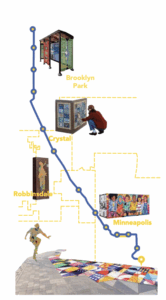By Janie Ye –Wayzata High School
Immigration from Asia is not a new occurrence. America was originally occupied by people of Asian-descent who crossed the Bering Strait tens of thousands of years ago. After Europeans discovered the Americas, there has been further immigration from Asian countries since the 19th century. Oftentimes, these Asian immigrants were (and still are) met by nativist resistance and sometimes even outright racism. Examining the causes and effects of immigration can allow for further analysis on nativism and discrimination.
 Many Asian immigrants decide to immigrate for better opportunities for themselves and their children. Demand for labor and the promise of freedom drew different groups of immigrants to the United States, the largest of which were from China. Today, there are around 2.5 million Chinese Americans in America, making them the largest group of Asians. The first wave of Chinese immigrants came during the 1848 Gold Rush, and tens of thousands still immigrate each year now. Immigrants from different countries come to America to escape oppression because of America’s democratic system and protection of liberties. Most immigrants end up improving their living conditions and financial situations after moving to America, which becomes an incentive for relatives and friends to also migrate. Ultimately, people from Asia (and most other places) immigrate for better lives.
Many Asian immigrants decide to immigrate for better opportunities for themselves and their children. Demand for labor and the promise of freedom drew different groups of immigrants to the United States, the largest of which were from China. Today, there are around 2.5 million Chinese Americans in America, making them the largest group of Asians. The first wave of Chinese immigrants came during the 1848 Gold Rush, and tens of thousands still immigrate each year now. Immigrants from different countries come to America to escape oppression because of America’s democratic system and protection of liberties. Most immigrants end up improving their living conditions and financial situations after moving to America, which becomes an incentive for relatives and friends to also migrate. Ultimately, people from Asia (and most other places) immigrate for better lives.
 Nativism is focusing on protecting the interests of people already established in an area. Nativists support excluding immigrants in various policies and rejecting change in the community, often believing that immigrants steal away opportunities. During the 1850s, Chinese miners worked for very low wages, resulting in less jobs for White miners. This combined with existing racism and resulted in a wave of nativist sentiment, which led to restrictions on immigration from Asia. Immigrants were also subject to discrimination and violence. Many were attacked and left out in job advancement opportunities. Oftentimes, nativists also reject others’ customs and views in defense of their own, refusing to acknowledge outside perspectives because of fear of foreign influence. Despite these challenges, immigrants established their own sense of culture and acceptance which can be seen in cultural communities like Chinatowns and Koreatowns.
Nativism is focusing on protecting the interests of people already established in an area. Nativists support excluding immigrants in various policies and rejecting change in the community, often believing that immigrants steal away opportunities. During the 1850s, Chinese miners worked for very low wages, resulting in less jobs for White miners. This combined with existing racism and resulted in a wave of nativist sentiment, which led to restrictions on immigration from Asia. Immigrants were also subject to discrimination and violence. Many were attacked and left out in job advancement opportunities. Oftentimes, nativists also reject others’ customs and views in defense of their own, refusing to acknowledge outside perspectives because of fear of foreign influence. Despite these challenges, immigrants established their own sense of culture and acceptance which can be seen in cultural communities like Chinatowns and Koreatowns.

Even in a modern world where immigration should be normal and accepted, racism still has negative effects on views about immigration. Islamophobia peaked after the tragic 9/11 incidents, even though the actions of a few do not reflect the beliefs of the majority. Although America prides itself on acceptance and freedom, discrimination against Muslims is prominent. Asian migration is not new and will continue to happen in the future, which is why it is important to have a positive and open mindset on immigration. After all, in the end everyone seeks happiness, and America is a country of immigrants.







